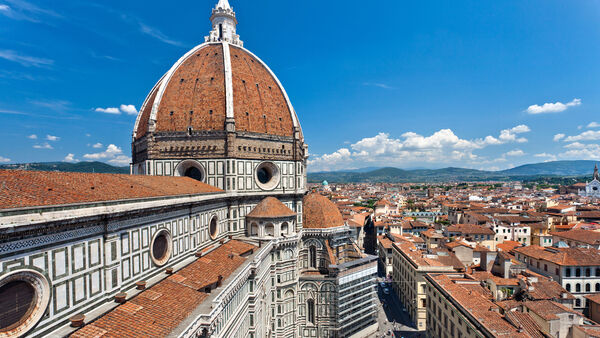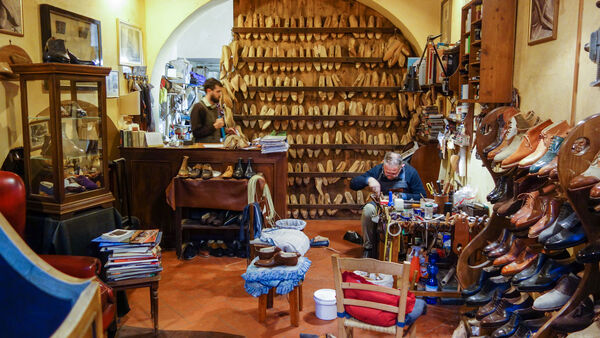Florence: The Cultural Capital of Europe
By Rick Steves

Geographically small but culturally rich, Florence — two hours northwest of Rome — is home to some of the greatest art and architecture in the world. Florence offers visitors a brimming bucket list of masterpieces, topped by Michelangelo's David, Botticelli's Birth of Venus, and Brunelleschi's heavenly dome. With more historic churches, masterpiece chapels, palaces large and small, and a surprising range of museums, the city is blessed with a wealth of cultural riches.
After Rome fell, Europe wallowed in centuries of relative darkness, with little learning, commerce, or travel. Then, around 1400, there was a Renaissance — a rebirth of the culture of ancient Greece and Rome. Starting in Florence, it swept across Europe. Wealthy merchant and banking families — like the Medici, who ruled Florence for generations — showed their civic pride by commissioning great art.
With the Renaissance, artists rediscovered the beauty of nature and the human body, expressing the optimism of this new age. The ultimate representation of this: Michelangelo's David. Poised at the end of a long, nave-like hall in Florence's Accademia Gallery, David is the god of human triumph. Clothed only in confidence, his toes gripping the pedestal, David sizes up the giant, as if to say, "I can take this guy." The statue was an apt symbol, inspiring Florentines to tackle their Goliaths.
Until 1873, David stood not in the Accademia, but outside Palazzo Vecchio, the former Medici palace and now Florence's city hall. A replica David marks the spot where the original once stood. With goony eyes and a pigeon-dropping wig, this David seems dumbfounded, as tourists picnic at his feet and policewomen clip-clop by on horseback.
Next door to the palace were the Medicis' uffizi — offices. Now these offices, as the Uffizi Gallery, hold the finest collection of Italian paintings anywhere, sweeping through art history from the 12th through 17th century, with works by Botticelli, Raphael, Giotto, Titian, Da Vinci, and Michelangelo. In the long, arcaded courtyard, a permanent line of tourists waits to buy tickets (advance reservations are a must to avoid these lines).
A highlight of the Uffizi is Venus de' Medici. Revered as the epitome of beauty, Venus is a Roman copy of a 2,000-year-old Greek statue that went missing. In the 18th and 19th centuries, wealthy children of Europe's aristocrats made the pilgrimage to the Uffizi to complete their classical education, where they swooned in ecstasy before the cold beauty of this goddess of love.
Classical statues like this clearly inspired Sandro Botticelli, my favorite Florentine painter. According to myth, Venus was born from the foam of a wave. In Botticelli's Birth of Venus, this fragile, newborn beauty with flyaway hair floats ashore on a clam shell while flowers tumble in slow motion. For me, the Birth of Venus represents the purest expression of Renaissance beauty.
In Florence, art treasures are everywhere you turn. The small, uncrowded Bargello features the best collection of Florentine sculpture anywhere, including works by Michelangelo, Donatello, and Ghiberti. And hiding out at the underrated Duomo Museum are Michelangelo's Pietà, the centerpiece he designed for his own tomb, and Ghiberti's Gates of Paradise panels. Revolutionary in their realism and three-dimensionality, these panels were created in response to a citywide competition to build new doors for the Baptistery, an event that some say kicked off the Renaissance.
Across the street from the Duomo Museum is Florence's famous cathedral. Boasting the first great dome built in Europe in more than a thousand years, the Duomo marked the start of the architectural Renaissance (later inspiring domes from the Vatican to the American Capitol). Designed by Filippo Brunelleschi, the immense dome — taller than a football field on end — rose in rings. First, he created part of the big white ribs, then filled in the space with interlocking bricks. When one ring was complete and self-supporting, he moved the scaffolding up and built another.
Today, the artistic legacy lives on in Florence's Oltrarno neighborhood, home to small artisan shops with handmade furniture, jewelry, leather items, shoes, and pottery. Craftsmen bind books and make marbled paper. Antique pieces are refurbished by people who've become curators of the dying techniques of gilding, engraving, etching, enameling, mosaics, and repoussé metal work. If you want to see a slice of today's Florence, this is the place to go.
At the end of the day, I like to unwind at one of my favorite hotels in town, Loggiato dei Serviti, a stately former monastery. From my bedroom I can see the Accademia across the way. The courtyard in between is gravelly with broken columns and stones set up for students to carve. Like creative woodpeckers, I hear the happy pecking and chirping of chisels gaining confidence, cutting through the stone. Hundreds of years after the Renaissance, it's comforting to know that the spirit of creation remains alive and well in Florence.

